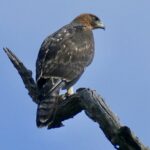The African hawk eagle (Aquila spilogaster) is a large bird of prey found across much of sub-Saharan Africa, from eastern Eritrea and Ethiopia in the north to South Africa in the south. This majestic raptor prefers tropical broadleaf woodland, woodland edges within the savanna, and riparian zones along rivers and watering holes. While they can adapt to thornbush areas and sparser savanna, they generally avoid evergreen forests and mountainous regions.
Preferred Habitat Characteristics
The African hawk eagle thrives in well-wooded countryside, often nesting in the forks of large trees. They tend to favor areas with moderate rainfall, avoiding both highly rainy regions like the Kenyan highlands and extremely arid localities. Their habitat is characterized by the following features:
- Woodland and Woodland Edges: The African hawk eagle’s primary habitat is tropical broadleaf woodland and the edges of these wooded areas within the savanna ecosystem.
- Riparian Zones: They are often found near rivers, ephemeral waterways, and watering holes, as these areas support the growth of taller trees and concentrate their prey.
- Thornbush and Sparser Savanna: While not their preferred habitat, the African hawk eagle can adapt to more open, thornbush-dominated areas and sparser savanna regions.
- Avoidance of Evergreen Forests and Mountains: This species generally avoids dense evergreen forests and mountainous terrain, preferring the more open, wooded habitats of the savanna.
Prey and Foraging Behavior
 Image source: African hawk-eagle by Charles J. Sharp
Image source: African hawk-eagle by Charles J. Sharp
The African hawk eagle is an opportunistic predator, feeding primarily on birds up to the size of guineafowl, with francolins being a staple part of their diet. They also hunt small mammals, such as mongooses and dassies, as well as reptiles. To catch their prey, they often perch on tall trees or soar over their hunting grounds, swooping down to capture their unsuspecting victims.
Breeding and Nesting
Breeding in the African hawk eagle occurs from May to July, with both the male and female taking turns incubating the eggs for up to 44 days. Due to the phenomenon of cainism, only one chick is typically reared, as the stronger hatchling often kills its sibling.
Conservation Status and Threats
The African hawk eagle is classified as Least Concern on the IUCN Red List, with a stable population trend. However, they face various threats, including:
- Habitat Loss: Deforestation and the conversion of woodland habitats to agricultural land or human settlements can reduce the available habitat for this species.
- Persecution: In some regions, the African hawk eagle may be persecuted by farmers or livestock owners who view them as a threat to their animals.
- Poisoning: The use of pesticides and other toxins can lead to the accidental poisoning of these raptors, either through direct exposure or through the consumption of contaminated prey.
Conclusion
The African hawk eagle is a remarkable raptor that has adapted to the diverse habitats of sub-Saharan Africa. From the tropical broadleaf woodlands to the sparser savanna regions, this species has found a niche in the region’s varied ecosystems. By understanding the specific habitat requirements and threats facing the African hawk eagle, we can better protect and conserve this impressive bird of prey for generations to come.


